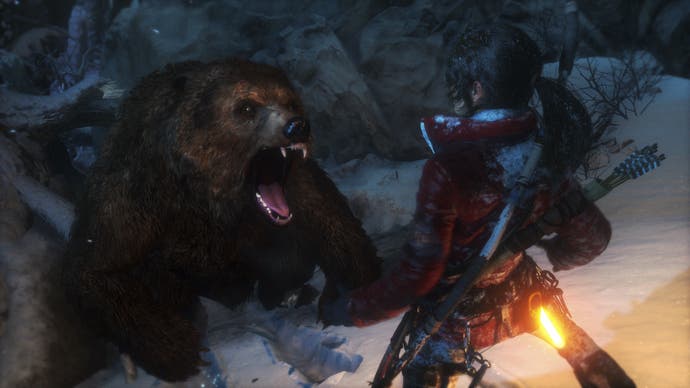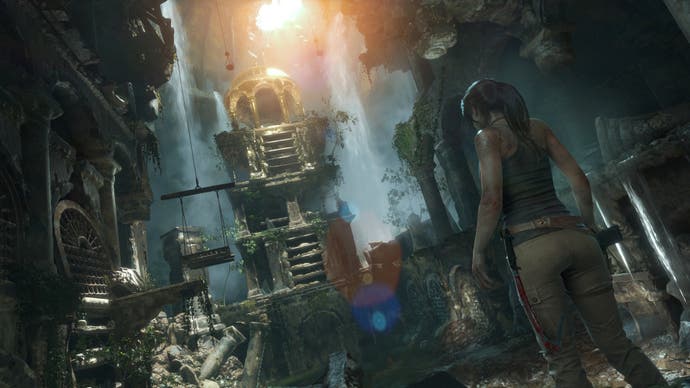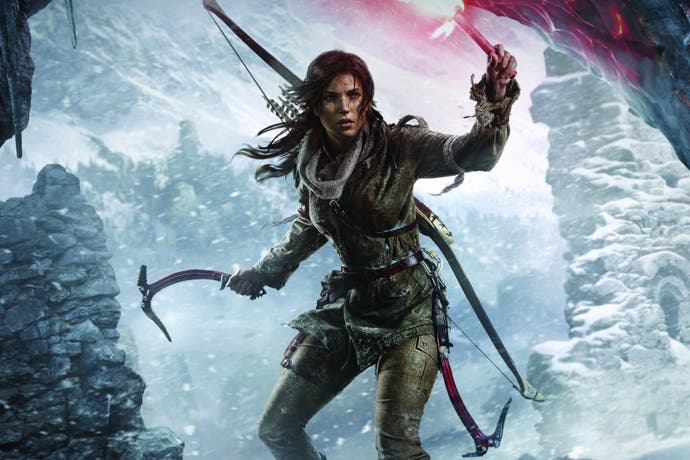Rise of the Tomb Raider brings back Lara's sense of adventure
Now we just need her sense of fun.
"We really wanted to send her on her first great tomb-raiding adventure. It's inspired by real-world adventurers, people like Sir Edmund Hillary and Tenzing Norgay, who climbed Everest," says Crystal Dynamics creative director Noah Hughes. That's all well and good Noah, but I'm struggling to recall when exactly Hillary or Norgay killed a grizzly bear with a poisoned arrow crafted from mushrooms harvested from an old tree stump. But hey, I'm not saying it didn't happen; my history is rusty at best.
Inspirations aside, it's good to see Rise of the Tomb Raider - a timed Xbox exclusive and sequel to 2013's Tomb Raider reboot - celebrate a renewed focus on survival and stealth alongside all-out combat, not to mention the actual raiding of tombs. The E3 demo I experienced is very clearly crafted to show off these new systems, and is split into two parts. The first takes place in the freezing Siberian wilderness and sees Lara split up from her friend Jonah following an avalanche, while the second, in stark contrast, takes her to the scorching heat of some ruins on the northwest border of Syria.
In Siberia, where she's on the search for a lost key to immortality, Lara narrowly survives an avalanche but risks being frozen to death unless she finds shelter by nightfall. Much of her gear was scattered during the landslide, so Lara needs to call upon her resourcefulness and the surrounding environment in order to survive the coming storm. Despite low visibility and deep snow drifts that hamper her movement, Lara is able to collect wood from nearby trees and the hide of a recently killed deer (which has otherwise been stripped clean by wolves).

The camera cuts to later, when night has fallen and Lara has built a fire and constructed a decent windbreak out of wood and moss. She's also used the hide she found to reinforce a makeshift bow. Resource gathering has increased importance in Rise of the Tomb Raider, Hughes tells us, and resources fall under common and exotic categories. Presumably, these classifications will affect the quality of your constructions, but it isn't really explained during our demo. Lara can craft things like regular and poison arrows on the fly, too, without having to return to camp with the ingredients she needs.
After being given all of five minutes to enjoy the warmth of the fire, Lara intercepts a radio transmission from Trinity, a generically named shady organisation (is there any other kind in these games?) that's after the same artefact she is. They've spotted the light from her camp and send a couple of lackeys out to investigate, but by the time they've shot up her shelter and wrenched the door open, she's gone - hiding in the treetops above. Crystal Dynamics took great care to explain that things like tree climbing and swimming feature much more heavily in this game, as part of a concerted effort to broaden the action into more than just shooting. And in fact, with Lara nimbly jumping through the treetops to avoid detection, she does feel much more like the Croft we know from the original games than the young girl from the reboot who screamed and fell down a lot.
Watching and waiting, Hughes says, will enable players to assess situations and engage intelligently instead of going in all guns blazing, though apparently you can still do that too. Lara briefly descends from the trees to harvest a couple of mushrooms, and from those constructs a poison arrow that she fires into the ground to create a noxious gas cloud that overwhelms two enemies at once. From there she enters an enemy camp, fires a standard arrow to distract one guard whilst shooting another in the back, steals his radio, throws it into the centre of camp to lure three or four guards over to investigate, and then throws a gas can into their midst, killing them all in one fell swoop. It's pretty badass.

If the guards were too easily dispatched, however, the giant bear that soon arrives on the scene is less of a pushover. Hughes mentions that in Rise of the Tomb Raider we'll see Lara tackle more animals, like she used to (but there was no confirmation of whether they will include critically endangered species or, er, dinosaurs). The bear is challenge enough for the time being; Lara is badly mauled by it as she runs away. She gets slowed down by choosing the wrong path and attempting to run through a snow drift, and promptly dies - the developer controlling her looks appropriately sheepish. Upon restarting, Lara hurls herself into a tangle of trees, where the bear attempts to claw its way inside. Lara embeds her axe in its skull but gets thrown down a ravine for her pains. She's safe for now, so uses berries and bandages to heal her wounds.
Atop the ravine, we spot a massive enemy installation, which Hughes describes as a hub which players can explore and where they can find many things to do, including secondary missions. You can also choose, upgrade and create different weapons in the surrounding area. For now, though, we go back and settle the score with that bear. Animals will roam around and guard their territory jealously, the devs tell us, and this bear stands between us and a cave that we need to pass through in order to advance the main story. Using multiple poison arrows, we're eventually able to bring it down, and wander into its den to find a massive galley ship frozen high up into the side of the cave.
From here the demo takes us from Siberia to Syria, where we see Lara prepare to raid an actual tomb. She's tracked a so-called immortal prophet here (if he was actually immortal, I assume he wouldn't need a tomb) by listening to her father's audio files, which she also regularly uses to solves puzzles and clues. Hughes explains that there is a system in the game whereby you can raise Lara's archeological intelligence. By reading more documents she'll be more proficient in spotting secrets, and you won't be able to decipher certain things and progress unless you dedicate the appropriate time to research.

As Lara climbs towards the entrance of the lost ruins, heat blasting off the sandstone, we're treated to some stunning views of the desert, of waterfalls, and of overgrown foliage, until, as per usual, things start collapsing. Trinity has followed Lara here too, so she's forced to high-tail it inside and squeeze through a very Indiana Jones-like tunnel, complete with skeletons and scorpions.
At least Indy would have cracked a joke; I found Lara a little irritating in this demo for the fact that, if she isn't screaming or reciting a piece of exposition aloud to no-one in particular, there's no character shining through. She doesn't so much comment on her surroundings as commentate on them, and it's a bit of a buzzkill. If Crystal Dynamics is so dead set on cultivating something like the Lara we all know and love, I do hope they work on her attitude, which is non-existent so far - even when she's back to puzzle-solving to raise water levels at the bottom section of a temple, using rafts, getting her foot caught in traps or having a quick swim. It's as if Lara isn't enjoying herself, which begs the question why she's doing all this at all.
The demo ends before we actually get to find whatever we're looking for, but we do reach the central part of the temple where a huge golden structure towers above us, odd angles poking out every which way. The players' task, Hughes says as the demo ends, is to find a way to the top. Now that, way more than shooting or stealthing or even axing bears in the face, sounds like Tomb Raider. And I'll bet Sir Edmund Hillary and Tenzing Norgay never did it either.









